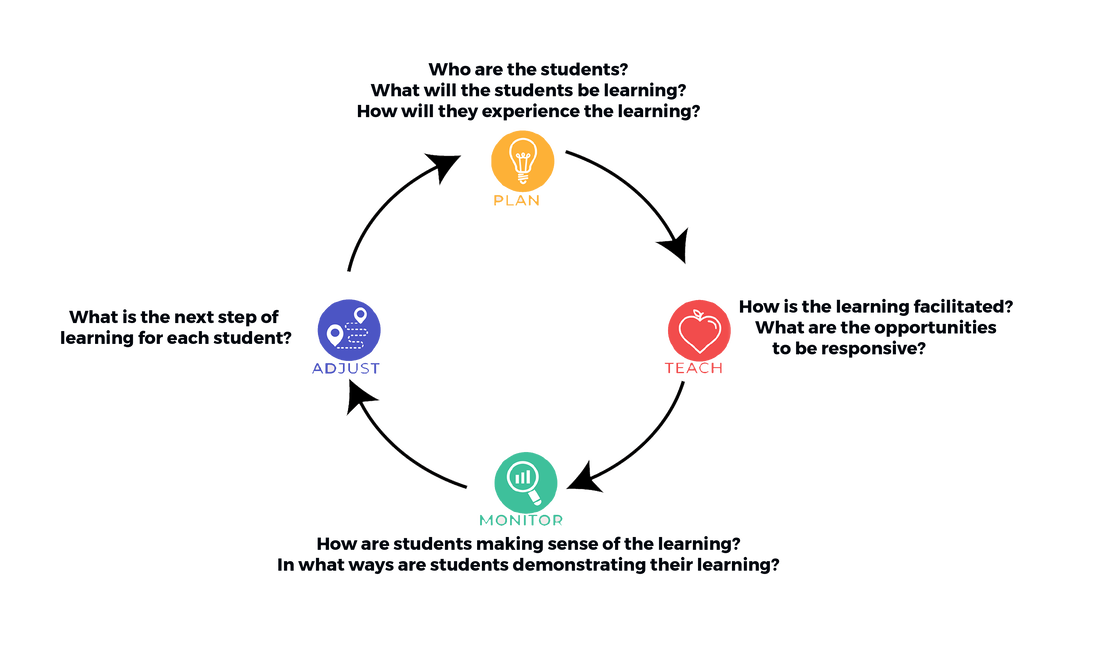Instructional Design
Student-Centered instructional excellence
The Student-Centered Instructional Excellence model illustrates the multi-dimensional approach to instruction that is used in CCSD. As teachers develop instruction that is based on a continuous cycle of Plan, Teach, Monitor, Adjust, the elements of social emotional learning (SEL), student behavior, and academics remain at the center of all teaching and learning. This instruction is further refined and enriched through collaborative work in Professional Learning Communities in order to meet the needs of each student.
Instruction is delivered through a multi-tier system of support in which all students are not just guaranteed access to learning (universal Instruction) but strategically supported with whatever additional needs they may require (strategic and intensive supports). This may include (but is not exclusive to) multilingual learners, students with a GT identification, and students with disabilities.
Embedded in each of these layers is CCSD's commitment to educational equity - ensuring that each student has the opportunity to thrive academically, emotionally, and socially, while remaining whole in an inclusive learning environment that creates a sense of hope and joy throughout their educational and life experiences.
Embedded in each of these layers is CCSD's commitment to educational equity - ensuring that each student has the opportunity to thrive academically, emotionally, and socially, while remaining whole in an inclusive learning environment that creates a sense of hope and joy throughout their educational and life experiences.
Plan - Teach - Monitor - Adjust
Instructional design in CCSD is developed through a continuous improvement cycle of "Plan, Teach, Monitor, Adjust." These four phases of the cycle guide teachers as they consider the deeper implications of the teaching and learning cycle.
The Professional Learning COmmunity (PLC)
A Professional Learning Community is a collective of educators who engage both in smaller Collaborative Teams and as a whole staff in an ongoing process in which they work collaboratively in recurring cycles of collective inquiry and action to create better learning experiences and achieve better results for each learner they serve. This ongoing process of planning, teaching, monitoring, and adjusting has a profound impact on the culture and structure of the system and the assumptions and practices of the educators within it. Becoming a Professional Learning Community requires a system to embrace and engage in three primary elements: developing a collaborative culture, focusing on learning, and being results oriented.
Focus on Learning
In a Collaborative Team, a focus on learning means that educators center students by creating effective learning conditions and experiences. Educators work to understand the strengths and needs of each student they serve and collaborate to ensure targeted, rigorous learning grounded in standards. In doing so, educators focus on their own learning to develop and deepen the expertise essential to their roles.
Collaborative Culture
In a Collaborative Team, collaboration represents a process of shared leadership and responsibilities in which teachers build authentic relationships while working together interdependently in order to positively impact their classroom practice in ways that will lead to better experiences and results for their students and for their team.
Results Orientation
In a Collaborative Team, being results-oriented means that educators focus on data and evidence of student experiences and outcomes related to identified learning goals and targets. Data and evidence is collected and analyzed in an effort to be responsive to the needs of students. As a part of this process, educators collaboratively assess practices, procedures, and programs to understand their impact on the experiences of all learners and the intended learning outcomes.
Collaborative teams
Collaborative teams are the engines of the Professional Learning Community. Collaborative teams are mutually accountable for shared student learning goals and work interdependently to analyze and improve their classroom practice. Collaborative teams engage in an ongoing cycle of questions and reflection that promotes deep team learning and higher levels of student achievement. Collaborative teams work to answer the following four critical questions in recurring cycles:
- What is it that we want our students to learn?
- How will we know if they have learned it?
- How will we respond for students who do not learn it?
- How will we respond if they already know it?
Use the slideshow below to search a variety of planning templates and resources.
(Click on any of the slides to open and download resources)
(Click on any of the slides to open and download resources)



